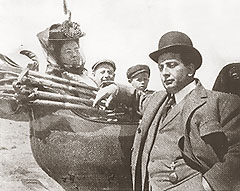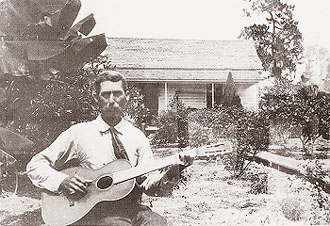|
The History of Lutz - Page 6 |
|
Read the left and right panes before scrolling down to the next levels. Click links to view related photos, use your back browser button to come back to this page. |
|
Click on links in text, they lead to more pictures |
|
|
|
|
Just before the time William & Charles' Lutz railroad junction was created, plans were in the making for a community in the area. Around 1905 a group of Chicago investors got together and formed the North Tampa Land Company. Its president was C. E. Thomas whose vision was a vast settlement where folks could buy tracts of land to farm and raise orange groves. The company investors narrowed the location down to two possible areas, Stemper or the Lutz Junction. Even before this decision was made, property in the area of the Lutz Junction wood stop and Stemper had already been sparsely settled.
C. E. Thomas (right), 1911
|
In 1910, the investors decided to build the town 20 miles north of Tampa and call it "North Tampa." The company bought 32,000 acres of land in northern "Hillsboro" County. The company founders had searched all over Florida before selecting this area. Stemper may have seemed the more logical choice because of all the activity going on around there, it already had a turpentine still, post office, commissary, depot, housing for workers, and 1/2 mile of railroad siding. But the Stemper Turpentine Company still had 200 acres tied up in turpentine leases, so the investors selected a site slightly further north, where Lutz Junction was located.
The Chicago-based company advertised its plans extensively all over the North and Midwest in newspapers, focusing heavily on Michigan, Indiana and Ohio. The company published a monthly publication, "The Hillsboro County Bulletin" at 835-837 Marquette Building in Chicago. |
|
T. J. Beaty, the county surveyor, was put in charge of surveying the entire property. The property would have an East and West plat, with the Tampa Northern railroad being the dividing line. Help came from Bert Frizzell, son of pioneers Marcus and Amanda Frizzell who had arrived there in the late 1800's. E. D. Hobbs, for whom Lake Hobbs is named, was the manager of the company's Tampa office. A. H. Chapman was in charge of sales, J. E. Martin was the on-site salesman and lived in Stemper.
|
A few years after the land sales began, C. E. Thomas decided that each individual who purchased 10 acres would be given a free lot in the town or burial plot in the cemetery. |
|
|
Around 1905 Joe Hanna bought property near the lake that is now named for him. His land was on the west side of present day Hanna Road which was named for him, about a 1/4 mile south of today's Sunset Lane. A street in old Seminole Heights in Tampa is named for his father, Josiah C. Hanna, Sr., as is popular swimming spot in the Hillsborough River in the old days, where the current swirls rapidly, "Hanna's Whirl." Hanna grew tropical fruit and citrus and furnished fruit and vegetables for the North Tampa Land Company exhibit at a 1911 land show in Chicago.
Like most settlers, Joe Hanna (left) built his house in the middle of his citrus grove in 1910.
|
|
|
|


